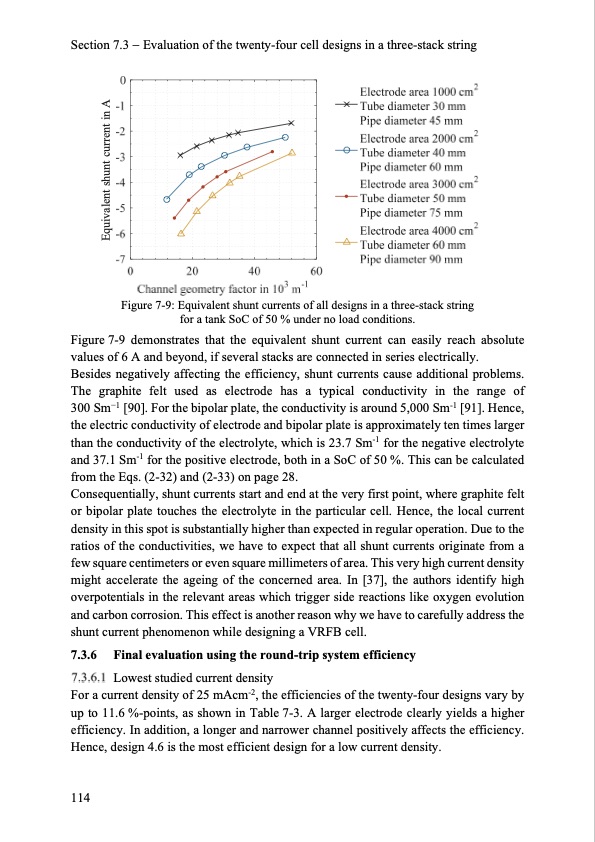
PDF Publication Title:
Text from PDF Page: 122
Section 7.3 Evaluation of the twenty-four cell designs in a three-stack string Figure 7-9: Equivalent shunt currents of all designs in a three-stack string for a tank SoC of 50 % under no load conditions. Figure 7-9 demonstrates that the equivalent shunt current can easily reach absolute values of 6 A and beyond, if several stacks are connected in series electrically. Besides negatively affecting the efficiency, shunt currents cause additional problems. The graphite felt used as electrode has a typical conductivity in the range of 300 Sm−1 [90]. For the bipolar plate, the conductivity is around 5,000 Sm-1 [91]. Hence, the electric conductivity of electrode and bipolar plate is approximately ten times larger than the conductivity of the electrolyte, which is 23.7 Sm-1 for the negative electrolyte and 37.1 Sm-1 for the positive electrode, both in a SoC of 50 %. This can be calculated from the Eqs. (2-32) and (2-33) on page 28. Consequentially, shunt currents start and end at the very first point, where graphite felt or bipolar plate touches the electrolyte in the particular cell. Hence, the local current density in this spot is substantially higher than expected in regular operation. Due to the ratios of the conductivities, we have to expect that all shunt currents originate from a few square centimeters or even square millimeters of area. This very high current density might accelerate the ageing of the concerned area. In [37], the authors identify high overpotentials in the relevant areas which trigger side reactions like oxygen evolution and carbon corrosion. This effect is another reason why we have to carefully address the shunt current phenomenon while designing a VRFB cell. 7.3.6 Final evaluation using the round-trip system efficiency Lowest studied current density For a current density of 25 mAcm-2, the efficiencies of the twenty-four designs vary by up to 11.6 %-points, as shown in Table 7-3. A larger electrode clearly yields a higher efficiency. In addition, a longer and narrower channel positively affects the efficiency. Hence, design 4.6 is the most efficient design for a low current density. 114 Equivalent shunt current in APDF Image | Model-based Design Vanadium Redox Flow Batteries

PDF Search Title:
Model-based Design Vanadium Redox Flow BatteriesOriginal File Name Searched:
10-5445IR1000070670.pdfDIY PDF Search: Google It | Yahoo | Bing
Salgenx Redox Flow Battery Technology: Salt water flow battery technology with low cost and great energy density that can be used for power storage and thermal storage. Let us de-risk your production using our license. Our aqueous flow battery is less cost than Tesla Megapack and available faster. Redox flow battery. No membrane needed like with Vanadium, or Bromine. Salgenx flow battery
| CONTACT TEL: 608-238-6001 Email: greg@salgenx.com | RSS | AMP |